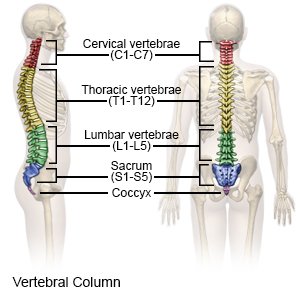Corpectomy
Medically reviewed by Drugs.com. Last updated on Aug 4, 2025.
Corpectomy is surgery to remove one or more vertebrae (bones) in the spine. This is usually done to take pressure off the spinal cord and nerves.
 |
WHILE YOU ARE HERE:
Before your surgery:
- Informed consent is a legal document that explains the tests, treatments, or procedures that you may need. Informed consent means you understand what will be done and can make decisions about what you want. You give your permission when you sign the consent form. You can have someone sign this form for you if you are not able to sign it. You have the right to understand your medical care in words you know. Before you sign the consent form, understand the risks and benefits of what will be done. Make sure all your questions are answered.
- An IV is a small tube placed in your vein that is used to give you medicine or liquids.
- General anesthesia will keep you asleep and free from pain during surgery. Healthcare providers may give you anesthesia through your IV. You may breathe it in through a mask or a tube placed down your throat. The tube may cause you to have a sore throat when you wake up.
- Antibiotics may be given through your IV at the time of your surgery. They help prevent infection caused by bacteria.
During your surgery:
- A large incision will be made near your vertebrae if you are having open surgery. Several smaller incisions will be made if you are having laparoscopic surgery. Your surgeon will remove tissue and bone with a drill or other tool. One or more pieces of bone may be taken from another area of your body, such as the hip. These pieces are used to fill in the space where bone was removed and are called bone grafts. Other materials, such as titanium or carbon fiber, can also be used as a graft. A metal plate may be placed over the graft and screwed into the surrounding bone to help support the spine.
- An x-ray may be done to check the placement of any grafts, plates, or screws used during surgery. A drain may be placed in your wound to remove fluid from the surgery area. The incisions will be closed with stitches and covered with bandages.
After your surgery:
- A brace may be placed on your neck or back to support your spine and decrease pain.
- Lie flat in bed until your healthcare provider says you can change your position. When you are able to lie on your side, your spine must be straight and your knees pulled up toward your chest. Your healthcare provider will give you a pillow to put between your knees to decrease pressure on your spine. Do not get up until a healthcare provider can help you. Your healthcare provider will tell you when you can get up on your own. You may be given exercises to do while you are in the hospital.
- The drain will be removed before you leave the hospital.
- Medicines may be given for pain or muscle spasms.
RISKS:
You may bleed more than usual or get an infection. Nerves in the area where the vertebrae are removed may be injured. Nerve damage can cause hoarseness or problems swallowing or controlling your bowel or bladder. You could lose the ability to move your arm or leg (paralysis) if your nerves are damaged. You may need to have more surgery. If you have a bone graft from your hip area, your hip could break or you could have problems walking.
CARE AGREEMENT:
You have the right to help plan your care. Learn about your health condition and how it may be treated. Discuss treatment options with your healthcare providers to decide what care you want to receive. You always have the right to refuse treatment.© Copyright Merative 2025 Information is for End User's use only and may not be sold, redistributed or otherwise used for commercial purposes.
The above information is an educational aid only. It is not intended as medical advice for individual conditions or treatments. Talk to your doctor, nurse or pharmacist before following any medical regimen to see if it is safe and effective for you.
Further information
Always consult your healthcare provider to ensure the information displayed on this page applies to your personal circumstances.
